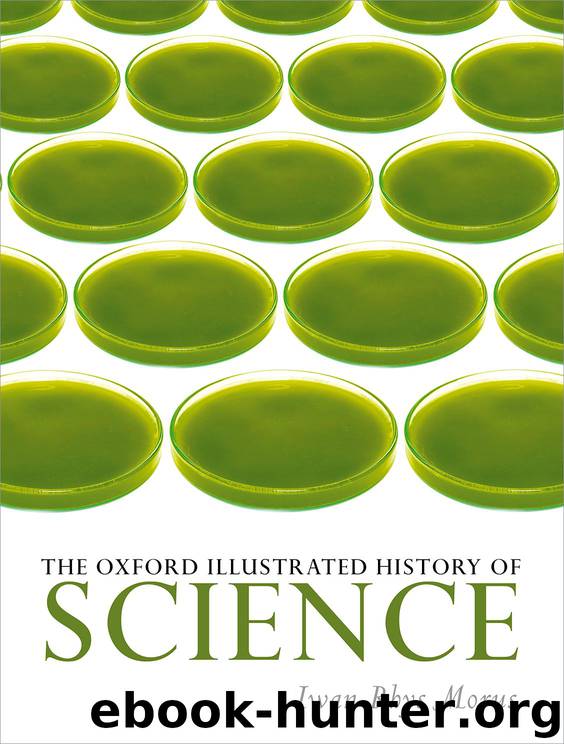The Oxford Illustrated History of Science by Rhys Morus Iwan;

Author:Rhys Morus, Iwan;
Language: eng
Format: epub
Publisher: Oxford University Press, Incorporated
Published: 2017-04-18T16:00:00+00:00
Callan’s invention of the induction coil and the improvements made by other instrument-makers to the original design produced what was to be the nineteenth century’s most significant piece of scientific apparatus. During the early 1850s the Paris-based German instrument-maker Heinrich Rühmkorff made significant improvements to the coil that made the device much more powerful. With this new source of intense electricity, experimenters could produce and investigate a variety of spectacular phenomena. In 1854, the English experimenter John Peter Gassiot used a Rühmkorff coil borrowed from his friend William Robert Grove to produce the effect known as Gassiot’s cascade. The cascade—in which the appearance of flowing liquid fire was created by passing electricity through a glass cup inside the vacuum of an air-pump—was an example of a discharge phenomenon, produced by passing high-tension electricity through an attenuated gas in a sealed glass tube or similar container. It was widely hailed as one of the most beautiful of experiments. The German instrument-maker Heinrich Geissler specialized in the production of intricately designed glass tubes in which different gases glowed in various colours with the passage of electricity. Gassiot, and others during the 1850s such as Grove and the German experimenter Julius Plücker, used Rühmkorff coils to try and discover the properties of these curious discharges.
William Crookes was one of the most energetic and prolific researchers into discharge phenomena during the 1860s and 1870s. His experiments provide illuminating evidence of the complex interplay between spectacle and systematic investigation. Crookes wanted to use discharges in order to investigate the properties of what he called the fourth state of matter. He produced some spectacular experiments, prompting the mathematical physicist George Gabriel Stokes to marvel to a correspondent that, ‘I know of nothing like what Crookes has been doing for some years. …I wish you could see some of the work in his laboratory.’ In one experiment, Crookes propelled a tiny glass locomotive down a track inside an evacuated tube by using the power of the ‘radiant matter’ flowing between the electrodes. Others, such as Plücker’s student Wilhelm Hittorf in Germany, or Warren de la Rue and Hugo Muller in England, worked on discharge phenomena too. Experiments like these took place at the boundary of the real in Victorian science. They were at the edges of what experiments could do. Crookes, for one, thought that they offered a good model of how experimenters might approach the study of other liminal phenomena such as those produced in spiritualist séances.
An array of Geissler tubes. Invented by the German instrument-maker Heinrich Geissler, apparatus like this, in which electricity passed through different gases producing brightly coloured discharges, offer a vivid example of the importance of spectacle for Victorian science.
Download
This site does not store any files on its server. We only index and link to content provided by other sites. Please contact the content providers to delete copyright contents if any and email us, we'll remove relevant links or contents immediately.
Learning SQL by Alan Beaulieu(6012)
Weapons of Math Destruction by Cathy O'Neil(5805)
Digital Minimalism by Cal Newport;(5355)
iGen by Jean M. Twenge(5143)
Sapiens by Yuval Noah Harari(5109)
The Age of Surveillance Capitalism by Shoshana Zuboff(3968)
Elon Musk by Ashlee Vance(3844)
Thing Explainer by Randall Munroe(3773)
Apollo 8 by Jeffrey Kluger(3498)
Future Crimes by Marc Goodman(3356)
The Science Book (Big Ideas Simply Explained) by DK(3129)
Who Can You Trust? by Rachel Botsman(3021)
I Live in the Future & Here's How It Works by Nick Bilton(2829)
Infinite Energy Technologies by Finley Eversole(2820)
Steve Jobs by Walter Isaacson(2744)
Dawn of the New Everything by Jaron Lanier(2679)
Chernobyl by Serhii Plokhy(2429)
The Innovators: How a Group of Hackers, Geniuses, and Geeks Created the Digital Revolution by Walter Isaacson(2398)
Energy Myths and Realities by Vaclav Smil(2370)
